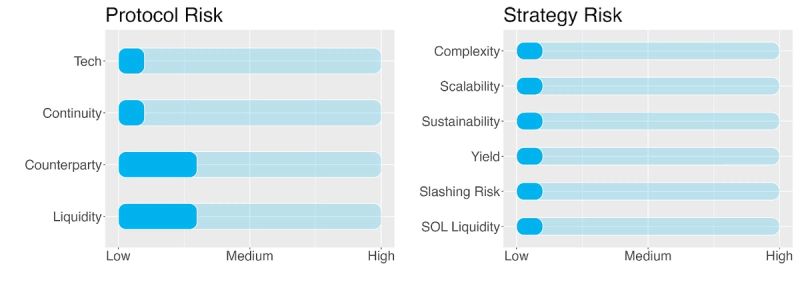Staking

The SOL Earn Strategy is now live!
With SwissBorg Earn, you can stake your SOL and expect a 5.5% APY.
Read on to learn how we checked it and the key points you need to know.
Key Takeaways
- Liquid staking represents one of the safest options in DeFi to generate a yield.
- We rely only on secure and trustable staking providers.
- The Yield (APY) is derived from SOL staking – contributing to the Proof-of-Stake consensus mechanism.
- The development of the Solana blockchain started in 2017. The first block was created in March 2020. Solana achieves consensus using a Proof-of-Stake mechanism and its proprietary model known as the ‘proof-of-history’ mechanism, which enables faster processing time and lower transaction costs.
- SOL liquid staking represents a very liquid yield-generating investment. There is no lock-up period and funds can be redeemed at any time.
- Risk Checklist: No risk is deemed as a concern for this strategy.
Nevertheless main potential issues could be related to:
- Counterparty risk
- Protocol liquidity risk
1. Strategy explained
The strategy is fairly simple; deposit SOL on the provider’s staking pool and receive staking rewards.
Lockup period: None. Assets can be redeemed at any time.
2. Risks
Trust Score
Only trustable and sound staking providers with top scores from CER are considered.
CER’s cybersecurity ranking is based on a comprehensive methodology that accounts for more than 20 indicators, including server and user security, a penetration test, bug bounty, and funds insurance
At SwissBorg we make sure that these are reliable and battle tested, and adhere to the highest standard of security.
The SwissBorg trust score for employed staking protocols is ‘green’ meaning they are trustworthy.
Protocol Risks
Project Continuity Risk
Overall Continuity Risk is deemed low.
Only top staking providers with reputable history of service are selected. This minimises the risks of continuity issues which would require the staking activity to be moved to a new provider.
Project continuity risk is set to 1/10.
Counterparty Risk
Overall Counterparty risk is deemed low.
Counterparty risk exists whenever an asset is handed over to an external provider. Any credit events involving the staking provider could affect the assets that have been entrusted to them.
That said, staking via a 3rd party is fundamentally different from depositing funds into a lending protocol that later becomes insolvent.
We seek to select only trustable staking providers in order to minimise counterparty risk.
Counterparty risk is set to 3/10.
Liquidity Risk
Liquidity Risk is deemed low.
Funds held by the staking provider are redeemable at any time (unless a different specific agreement was agreed upon).
It is possible that in the event of extreme adverse market conditions some of the providers’ funds would be placed under pressure and, although very unlikely, this could pose liquidity constraints on the platform.
Liquidity risk is 3/10.
Strategy Risk
Complexity
Complexity of strategy is low.
The strategy involves depositing SOL which is used for staking purposes; to validate the transactions on the Solana network.
Staking is the most basic form of yield generating strategy in crypto and therefore more reliable.
Complexity of the strategy is 1/10.
Scalability
Scalability risk of strategy is low.
Staking is a highly scalable practice. Indeed, the more stakers are participating, the higher the safety of the blockchain.
Scalability risk of the strategy is 1/10.
Sustainability
Sustainability risk of strategy is low.
The yield obtained from this strategy is fully sustainable as it comes from participating in the validation of Solana transactions, the Proof-of-Stake mechanism.
Proof-of-Stake is quite energy efficient when compared to Proof-of-Work chains like Bitcoin and has therefore practically no negative impact on the environment.
Sustainability risk of the strategy is 1/10.
Yield Risk
Yield risk of strategy is low.
Staking provides a constant stream of income with low variability.
Yield risk of the strategy is 1/10.
Slashing Risks
Slashing risk on Solana is low.
The Proof of Stake consensus mechanism requires participants to behave responsibly for the overall good of the ecosystem. For this reason, blockchains penalise validators if they step out of line by slashing the value of their stake. The two most common offences are double-signing or going offline when the validator should be available to confirm a new block.
The best protection against these risks is to work with an institutional-grade validator that protects against double-signing and downtime.
Automatic Slashing is not currently enabled on Solana with the Solana team instead implementing manual safety checks.
Penalties currently include 100% slashing when the node is acting maliciously with examples including those just mentioned as well as signing illegal transactions, and voting for illegal forks.
When a safety violation occurs, the entire chain is brought to a halt, requiring the team to manually search for the node(s) that caused the violation and propose that the stake be reduced after the network is restarted. The stake of the bad node would then be reduced to zero, or the validators could try to vote to remove the offending node. When a node is slashed, all delegated stake from that node are removed.
SwissBorg Earn staking strategies seeks to minimise the risk of slashing by employing staking protocols that thoroughly monitor all validators by means of a dedicated team of professional Site Reliability Engineers and Development / Operations experts.
So far there haven’t been any instances of slashing events.
Slashing risk is 1/10.
Liquidity Risks of staking
Liquidity Risk on staking SOL is low.
Most staking opportunities require the investor to lock-up their tokens for an agreed period, for hours to days, and even months. Regardless of the direction the market chooses during this time, your assets will be out of reach.
In more liquid staking systems however, stake is added to a liquidity pool and redeemable at any time. This is also the case with staking on SOL.
Liquidity risk is therefore set to 1/10.
3. Conclusions
SOL staking comes with little risk.
Because only trustworthy and sound staking providers with top scores from CER are considered when building a staking pool for SOL, the changes or malicious players is negligible, making the SOL Earn Strategy a solid player in the space.
Ever since going live in 2020, SOL has risen in the ranks behind bigger brother Ethereum using its comparative advantages of transaction processing speed and lower transaction costs, and with yield coming from securing transactions on the Solana blockchain, it is continuing to solidify its uses and reputation in the space.
Additionally, the fact that SOL staking represents a very liquid yield-generating investment with no luck-up periods and available redemption at any time, gives stakers extra incentive to contribute.
The SwissBorg Risk Team ranks SOL staking as a Low risk investment, one for an investor with some understanding of DeFi and yielding, who is willing to take on a minimum amount of risk – while remembering that there is no free lunch! – in exchange for an acceptable reward on SOL.
Try the SwissBorg Earn today!






